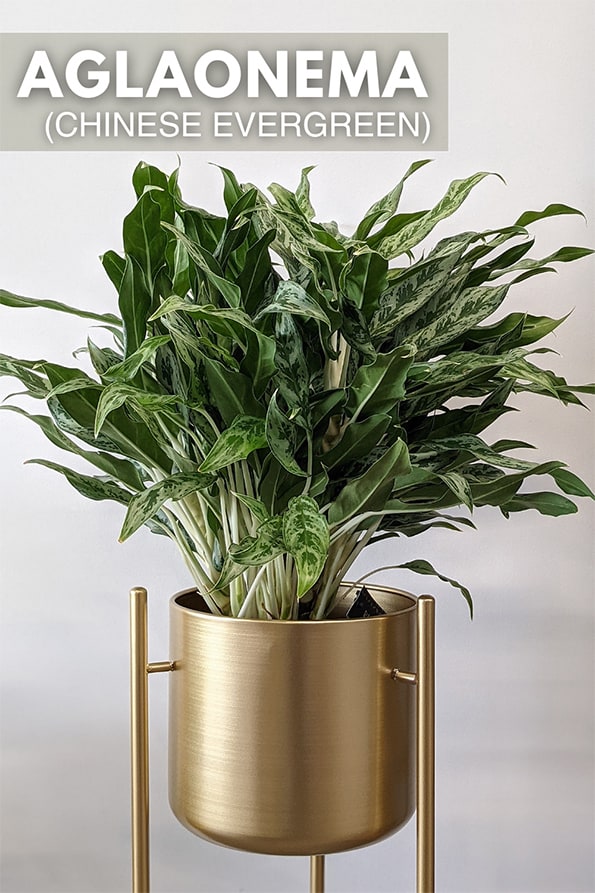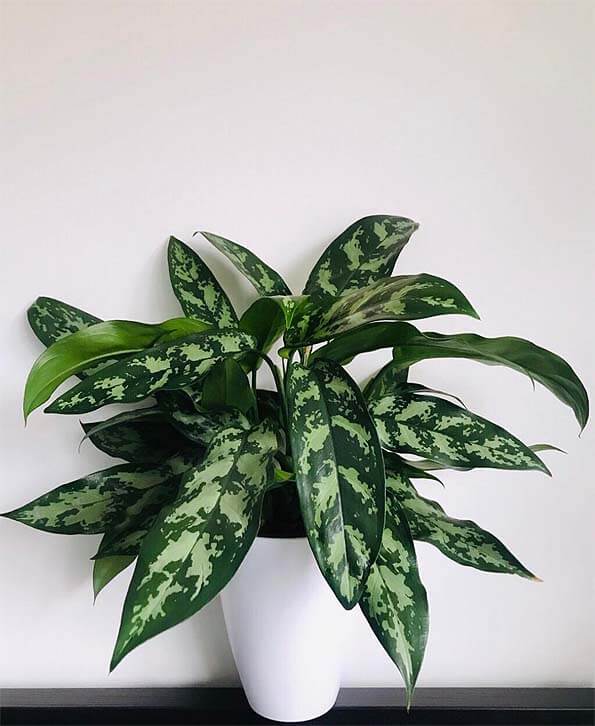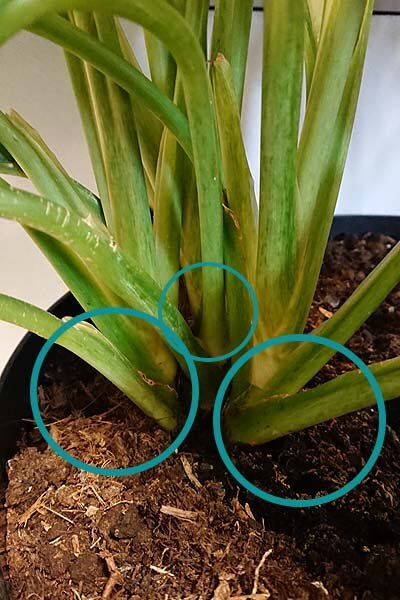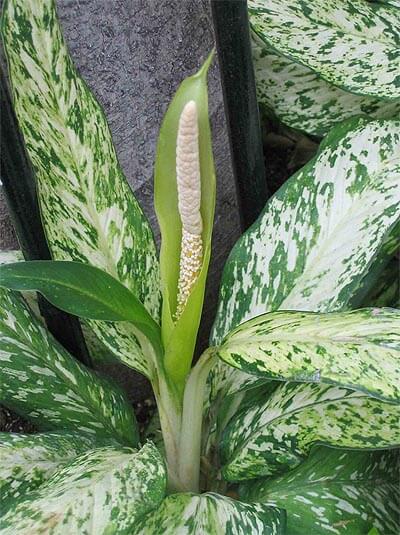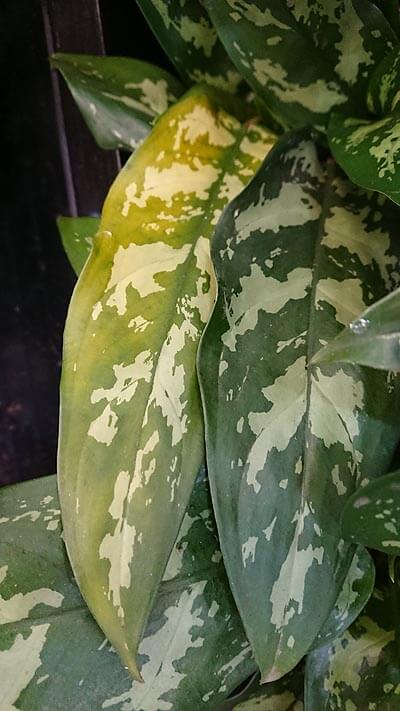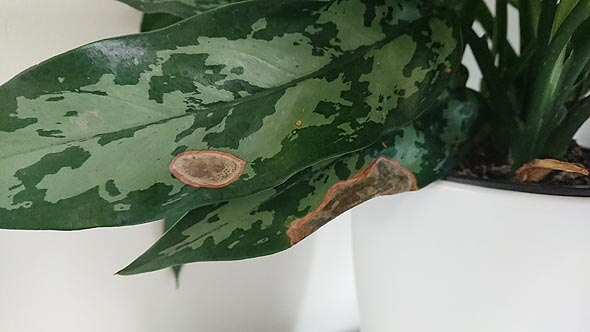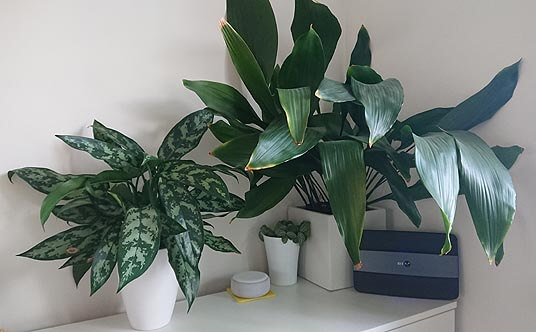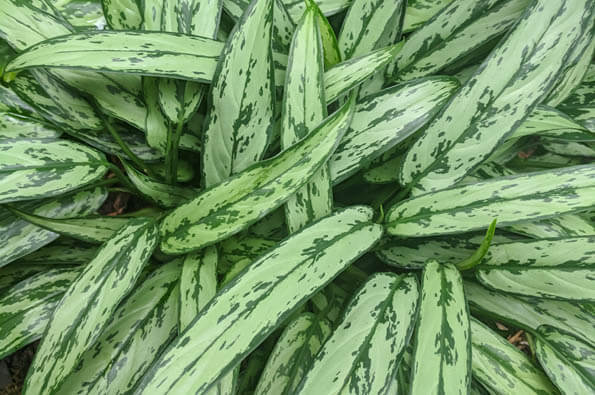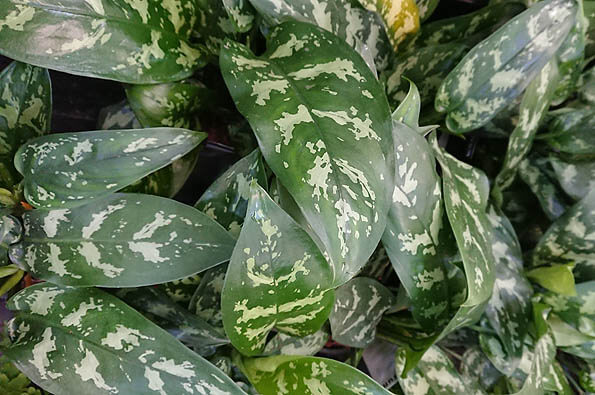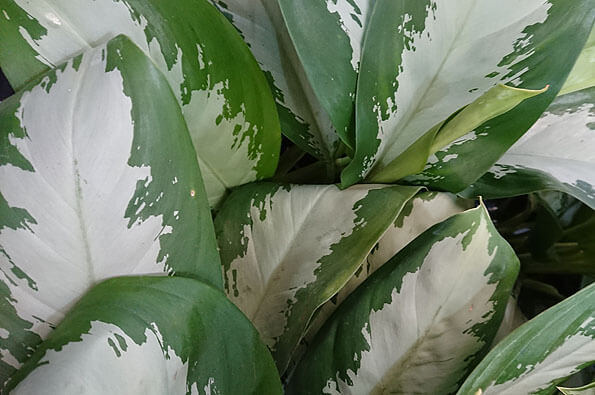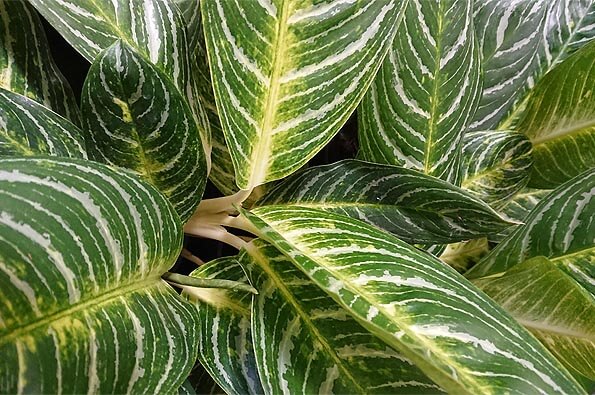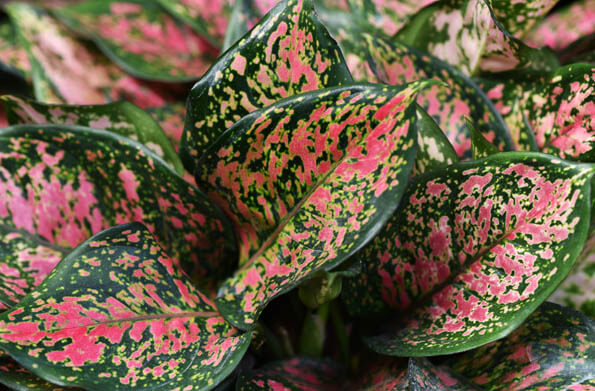The Chinese Evergreen or Aglaonema is a decorative foliage houseplant that thrives in our homes and workplaces. Tolerant of low light conditions and sporadic care, they're perfect plants for beginners but remain equally attractive to experienced hands.
They don't necessarily have the wow factor that many other indoor plants have, but Chinese Evergreens are seriously understated.
The color variations you can find are huge, they grow fairly slow and take a long time to outgrow their pots, meaning ongoing maintenance is minimal.
Although they're tropical plants, the Chinese Evergreen plant makes for a superb easy care houseplant.
They're hardy and for the most part easy-going. In fact, they're some of the least fussy houseplants going. Aglaonemas, in general, are also incredibly versatile and adaptable to a variety of indoor environmental growing conditions.
How do you pronounce Aglaonema correctly? Say:
Ag-low-NEE-muh
Botanical name
Around 22 Aglaonema species attached to the Botanical name of "Aglaonema". However, there are hundreds of different varieties and cultivars to pick from. I've listed some of the more popular ones at the end of this article.
They're native to tropical and subtropical regions of Asia, so they do need a warm location in your home and do need some humidity to perform at their best, although in the average home neither of these things are normally a problem.
They used to be a very common plant, but fell out of favor. I'm guessing this was because in the past you could only get a handful of varieties and they became a little boring for most people.
However, over the last 10 years, growers have come up with more interesting looking Aglaonema cultivars and varieties. Most are pretty common to find in stores which translates into them being fairly priced.
The common name for Aglaonema is "Chinese Evergreen". A few decades ago they used to be some of the most popular houseplants on the market.
I'll do a separate guide in the future to show you some of what's on offer today. But the more popular and common Chinese Evergreens you'll come across can be found at the bottom of this article.

Hi, I'm Tom!
If you're like me and enjoy the challenge of growing houseplants and getting them to thrive, then Ourhouseplants can help. This website shares my knowledge and years of growing plants and provides (hopefully) helpful advice on properly caring for your indoor plant friends.
In most cases Aglaonema plants are not sun lovers. Bright intense sunshine can damage their leaves so this position is best avoided.
They actually make perfect plants for your low, medium or semi-bright light locations in your homes. They'll give a splash of greenery and thrive in spots that other houseplants will struggle with.
They won't survive indefinitely in very poor light levels or in no light conditions though, so don't even think about trying it in windowless rooms.
In general, Aglaonema with light green or heavily variegated types will need more light than those with darker green leaves or less variegation. Follow that rule, and you shouldn't go too far wrong.
These plants like their soil to be just damp / moist. No sodden soil or allowing it to fully dry out. They will cope with both of these things occasionally but try not to let it happen too often as it stresses the plant.
In Winter, or if your plant is in a lower light location, it might only need watering once every two weeks. In brighter, light locations or if the temperature is very warm watering once or twice a week might be needed.
In ideal cases, you'll never see either of the below warning signs because you've been looking after your plant like I've told you, right? However, on the off chance something has accidentally gone wrong, these are the signs to look out for and what they mean.
Although they're tough, they are ultimately tropical plants, and given the choice, they'd prefer high humidity.
They can still cope reasonably well with low humidity conditions though. They just won't do quite as well if the air in your home or workplace is dry so do bare this in mind.
Growing and active plants will enjoy a feed every few weeks using a normal houseplant fertilizer.
They'll still do perfectly well with less frequent feeding. There is also no need to feed in Winter.
True to its tropical origins, Aglaonema plants love it warm. In fact, they crave it. Avoid cold rooms and cold drafts at all cost, they want to be snug and cosy all year round.
The warmer they are, the better they grow. Keep them in your living spaces and away from unheated guest rooms or cool porches. Aim for temperatures 18°C (64°F) and above.
The warmer they are, the better they grow.
Most Aglaonema plants tend to grow slowly and because of their short stems, this means they stay compact for quite a while and it will be many years before they outgrow a pot.
Of course, this will eventually happen and so when you notice the plant is particularly congested or there has been no new growth for a long time, it's probably time to repot it into a larger pot or container.
Did you know?
In their native southeast Asia, people have grown them for centuries as good luck bringing plants.
They'll grow well in a variety of different growing medium mixes so in most cases you can just use whatever you already have to hand for your other indoor plants. Anything labeled as suitable for houseplants or garden plants will be fine.
Chinese Evergreens look beautiful and certain varieties are bound to catch the eye of visitors and illicit positive comments. You might even be asked for a cutting as a present. The good news is that you can propagate them quite easily if you're feeling generous.
There are two main ways of creating new plants. Division and cuttings.
Division.
Each mature plant usually has a cluster of offsets that give it the "bulk" of the overall plant. If you're happy to split and break everything down, division is the way to go.
Remove the plant from its container and wash off or remove the soil so you expose the roots and can easily identify all parts of the clump. It's then a case of separating everything.
You can propagate Aglaonema by division. In this photo you can see three potential new plants.
You can easily divide the clump with just your hands and I'd recommend trying it this was first. Tools can be harsh and too precise. Your hands will be more gentle and cause the splits to be more random and this should allow each piece to come away with some of the roots.
After separating everything, just plant each section into its own pot or container. Use a similar potting to what it was growing in before and keep the environmental conditions the same. The new plant should be fully established within a few months.
Tip
If you're not sure about division because it sounds too radical or you just want to take a smaller cutting from the main plant, then give stem cuttings a go instead.
Cuttings.
Use a sharp knife to cut away a stem at the base of the plant.
In your hand, you should be holding the leaves and the main step without any roots. You can then pop the cutting into a cup of water and new roots should start to appear over a few weeks.
Once the roots have formed in the water (or you want to just skip the water rooting step) you can put the cutting into a pot filled with potting soil and grow on in the usual way.
Here is a super helpful YouTube video covering both propagation types described above.
This helpful video will show you how to create more Aglaonema plants for free
In general, this is a slow growing plant. You can increase growth rates with warm temperatures and bright light conditions. This will trigger most Chinese Evergreens to produce new growth at a more moderate rate. I share more speed growing tips over in this article if you want more ideas.
If the temperature is cooler or the light levels lower, growth will be much slower. Plants grown in very low light places are unlikely to produce any new growth at all.
This varies considerably between the different varieties. As a general rule, these will almost always be moderately low growing and compact houseplants.
The plant you buy in the store will get bigger over time, but is unlikely to grow significantly in height or width even after several years.
These plants do sometimes produce flowers, however as with many indoor plants with attractive foliage, the flowers are quite dull in comparison. You're likely to see them in Summer, but they can appear at all times of the year when being grown indoors.
The Chinese Evergreen does flower on occasion as this photo taken by HQshows
These are poisonous plants, however it rarely seriously harms human or animal, (I've not been able to find any documented cases of it happening).
When considering safety, the problem here is that all parts of the plant contain microscopic needle-shaped calcium oxalate crystals and when some unfortunate animal (or person) eats a bit, they end up with a painful and swollen mouth. Not life-threatening, but not nice to experience or see someone suffering with.
Some Aglaonema plants will produce red berries when the flowering period is over (see flower section above). Although children and animals will not usually eat plant leaves, they might be more tempted by the berries. I recommend removing the flowering stalk before the berries form, just to be safe.
Dust can be a problem for these houseplants, especially on older plants that have just been left to do their thing.
Their slow-growing nature means it's easy for dirt to accumulate and cover the leaf surface. Make sure you wash them down from time to time to keep things clean and the foliage vibrant.
Yellow Leaves.
Some leaves will go yellow from time to time. That's normal. If quite a few do this, or it happens more than once or twice a year, then you could have a problem.
Yellowing Chinese Evergreen Leaves
Typically, problematic yellowing like the above would be caused by one of the following:
Brown Leaf Tips.
This is fairly unusual in most homes. But you can expect brown tips if the humidity is low or there is a lot of hot dry air being blown over the leaves. For example if the plant is positioned above a radiator or above a heat vent.
Some people have reported that if they use water from the tap and live in a hard water area, over time this encourages the build-up of minerals in the soil and corresponding brown tips.
I've not noticed this personally on my plants, but it's possible some varieties are more prone to this than others.
Brown Leaf Spots.
If the brown is crispy and dry, occasional and is present on older leaves then it's likely to be sun damage. These are semi-shade loving houseplants and direct sunlight falling on the leaves will cause them to quickly burn and create scorch marks.
This Chinese Evergreen has brown spots caused by sun damage
Pests.
For sure this is a hardy houseplant with a positive can-do attitude. It puts up with a lot and can resist most pests, but it's not immune to some of the fairly common ones that afflict indoor plants.
Spider Mites, Scale Insects, Mealybugs and Aphids are all possible. Signs of pests usually involve sticky reside on the leaves or potentially yellow leaves appearing if the infestation is quite bad.
In my years of growing them, I would say it's rare to have pest issues, but if you do, have a read of our pest article for guidance.
Leaf Position Changes
Not the worst thing that could happen to your plant. In fact it's actually communicating with you and letting you know what's wrong. Helpful things are Aglaonemas.
Leaves Wilting.
This will usually happen when your Chinese Evergreen plant has been overwatered. Don't make the mistake of thinking it's been underwatered and pour more on.
If you see this happening have a feel of the soil to check. If the potting mix is wet then hold back on the watering for a week or two until it dries out again. If the soil is dry then the wilting has been caused by underwatering.
If you struggle with watering plants in general then make sure you use a container or pot that has a drainage hole (or two) as this will let excess water escape and reduce the possibility of root rot setting in.
Leaves and Stems Standing Tall.
This will happen to some varieties when your plant has been underwatered. It's quite a sight to see, but if you see it then give it some water as soon as you can. Going forward try and keep the soil moist instead of letting it dry out completely.
On the surface, the Aglaonema should have been the ideal houseplant. I've always tended to live in homes that had a strong North facing aspect and the resulting low light situation these tend to have.
Plus in the early days of houseplant ownership, like many people, I made my share of silly mistakes so could have done with a few more hardy ones. But this houseplant just never did it for me and I shunned it. Massively.
In some ways, it seemed a smaller Aspidistra substitute without any of the grandeur and history. In particular, it was Aglaonema Silver Queen that did the damage. For some reason where I lived, it was constantly grown in places that most people do not want to spend any time in - Dentist waiting rooms and hospitals.
So the last thing I wanted was one of these anxiety-inducing bad memory houseplants rocking out in my living room!
Aglaonema in a living room next to an Aspidistra plant.
Times change though and so did the Aglaonema. I'm now sharing my home with several different varieties that really thrive with minimal effort.
One is actually positioned next to a splendid Aspidistra, and they really don't look the same at all. I don't know what I was thinking, cousins at best!
In total there are possibly over a hundred different types of Chinese Evergreens so we can't cover the entire range here, but below are some of the more familiar ones.
Aglaonema Silver Queen was one of the early hybrids that interior designers fell in love with. With its skinny marbled silvery-green lance shaped leaves they appeared everywhere from hospitals to shopping malls. A fantastic variety for under-planting when using tall floor plants with few lower leaves.
Perhaps not as popular as they were 20 years ago. But they're still sold and because of Aglaonema's general long-lived nature, that means there will be plenty of established Silver Queens still growing happily around the world.
If you like the patterns but would prefer a more compact look then check Maria Christina.
A. commutatum 'Silver Queen' - photo by Mark Bosky
Aglaonema Maria has wider but shorter leaves compared to some of the others on offer. It also has a much lower and compact appearance so could easily be overlooked. The glossy leaves are dark green splashed with small splashes of silvery blotches that helps the plant to stand out.
The darker leaves mean Maria will do better than the others in darker spaces and its smaller nature makes it a great specimen houseplant for those awkward locations that you want to fill with something green.
Chinese Evergreen Aglaonema Maria.
One of the largest growing varieties, with a sharp-looking leaf due to the longer and wider leaf shape.
Go for Diamond Bay or Silver Bay if you want a standout plant that draws the eye. They can be grown under a taller plant with an exposed trunk, such as a Yucca or Dragon tree or by themselves, it's highly flexible.
The leaves have a light green edge and a large wide center stripe that is greeny-creamy white, the two shades meet at an irregular border. It does need more light than other types, so keep it out of dark corners to help it perform at its best.
A. modestum 'Diamond Bay'
The vivid Aglaonema Key Lime has, as the name gives it away, colorings that resemble a Key Lime. Several shades of green and yellow in narrow bands cover the entire leaf held in the air with contrasting creamy stems.
In my experience, they tend to be harder to come across and slightly more expensive compared to the others. Although they could still be worth a second look as they're very striking and grow to a large size making a great indoor plant in the process.
They're potentially better suited as a stand alone to really let it show itself off.
Aglaonema 'Key Lime'
The bulk of Chinese Evergreens play around and mix things up with different shades of green. But the Red Aglaonema bring in splashes of red and pink making them very unusual and pretty. Indirect sunlight will make the colors pop. They can also cope with slightly higher light intensities.
Three of the more popular ones are Red Ruby which has dark green leaf edges with splashes of solid pink in the center (see photo below). Siam Aurora which has pinky-red leaf edges that carry on into the stems, almost like rhubarb. (see a quick 10 second video tour of this variety - it's stunning!).
Light Star is also very similar to Siam Autora, but has a little less color. Finally, Aglaonema Crete is more subtle than the previous two, it has thin pink leaf edges and young rhubarb colored pink stems.
Aglaonema Chinese Evergreen Red Ruby - photo by David Clode
As pointed out earlier there are so many different Chinese Evergreen plants that we can't cover them all. But we know our visitors love looking at the different varieties available, so if you'd like to share a photo of yours, please do post it in the comments below or on our Facebook page.
(Article / Gallery) Photo credit A. commutatum 'Silver Queen' - Mark Bosky
(Article / Gallery) Photo credit of Red Aglaonema 'Red Ruby' - David Clode
(Article / Gallery) Photo credit of the flowering Aglaonema - HQ
